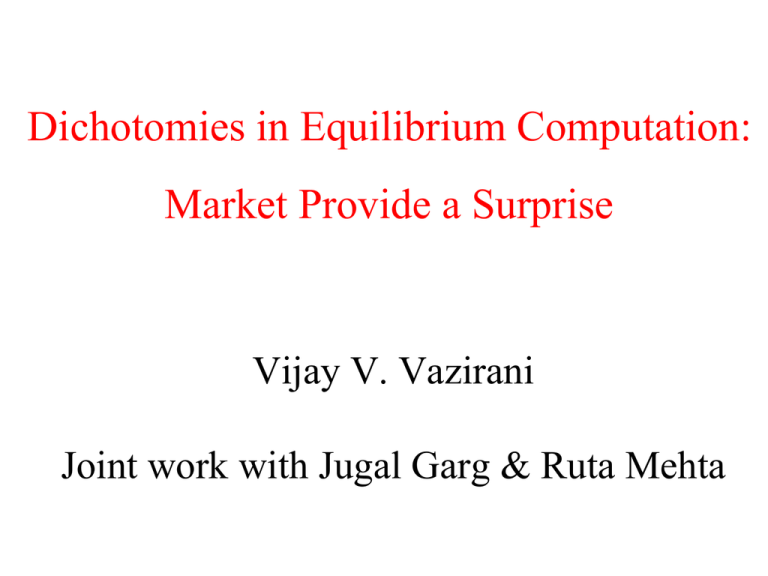Vazirani
advertisement

Dichotomies in Equilibrium Computation:
Algorithmic Game Theory
Market Provide a Surprise
and Internet Computing
Vijay V. Vazirani
Joint work with Jugal Garg & Ruta Mehta
Equilibrium computation
Has its own character, quite distinct from
computability of optimization problems
Natural equilibrium computation
problems exhibit striking
Dichotomies
2-Nash
Nature of
solution
Rational
k-Nash, k>2
Algebraic;
Irrational eg:
Nash, 1950
Complexity
PPAD-complete FIXP-complete
Practical
algorithm
Lemke-Howson
??
Arrow-Debreu Model
n agents and g divisible goods.
Agent i: has initial endowment of goods Î R
g
+
and a concave utility function
(models satiation!)
ui : R ® R+
g
+
Arrow-Debreu Model
n agents and g divisible goods.
Agent i: has initial endowment of goods Î R
g
+
and a concave utility function
(piecewise-linear, concave)
ui : R ® R+
g
+
Agent i comes with
an initial endowment
At given prices, agent i
sells initial endowment
p1
p2
p3
… and buys optimal bundle
of goods, i.e, max ui (bundle)
p1
p2
p3
Several agents with own endowments
and utility functions.
Currently, no goods in the market.
Agents sell endowments
at current prices.
p1
p2
p3
Each agent wants
an optimal bundle.
p1
p2
p3
Equilibrium
Prices
p s.t. market clears,
i.e., there is no deficiency or surplus
of any good.
Arrow-Debreu Theorem, 1954
Celebrated theorem in Mathematical Economics
Established existence of market equilibrium under
very general conditions using a deep theorem from
topology - Kakutani fixed point theorem.
Kenneth Arrow
Nobel
Prize, 1972
Gerard Debreu
Nobel
Prize, 1983
Arrow-Debreu Theorem, 1954
Celebrated theorem in Mathematical Economics
Established existence of market equilibrium under
very general conditions using a theorem from
topology - Kakutani fixed point theorem.
Highly non-constructive!
Computability of equilibria
Walras, 1874: Tanonnement process
Scarf, Debreu-Mantel-Sonnenschein, 1960s:
Won’t converge!
Scarf, Smale, … , 1970s: Many approaches
Open problem (2002)
Separable, piecewise-linear, concave
(SPLC) utility functions
Separable utility function
For a single buyer :
Utility from good j, f j :
+
®
+
Total utility from bundle, u(x) = å f j (x j )
j
f j : piecewise-linear, concave
utility
amount of j
f j : piecewise-linear, concave
utility
SPLC utility: Additively
separable over goods
amount of j
Markets with separable,
piecewise-linear, concave utilities
Chen, Dai, Du, Teng, 2009:
PPAD-hardness
Chen & Teng, 2009:
PPAD-hardness
for Arrow-Debreu model
for Fisher’s model
V. & Yannakakis, 2009:
PPAD-hardness
for Fisher’s model
Markets with separable,
piecewise-linear, concave utilities
V. & Yannakakis, 2009:
Membership in PPAD for both models.
Markets with separable,
piecewise-linear, concave utilities
V. & Yannakakis, 2009:
Membership in PPAD for both models.
Indirect proof, using the class FIXP of
Etessami & Yannakakis, 2008.
Open
The definition of PPAD was designed to capture
problems that allow for path-following algorithms,
in the style of Lemke-Howson and Scarf …
It will be interesting to obtain a natural, direct
algorithm for this task (hence leading to a more
direct proof of membership in PPAD), which may
be useful for computing equilibria in practice.
Complementary Pivot Algorithms
(path-following)
Lemke-Howson, 1964: 2-Nash Equilibrium
Eaves, 1974: Equilibrium for linear
Arrow-Debreu markets
(using Lemke’s algorithm)
Eaves, 1975 Technical Report:
Also under study are extensions of the overall method to
include piecewise-linear utilities, production, etc., if
successful, this avenue could prove important in real
economic modeling.
Eaves, 1976 Journal Paper:
... Now suppose each trader has a piecewise-linear, concave
utility function. Does there exist a rational equilibrium?
Andreu Mas-Colell generated a negative example, using
Leontief utilities. Consequently, one can conclude that
Lemke’s algorithm cannot be used to solve this class of
exchange problems.
Leontief utility (complementary goods)
Utility = min{#bread, 2 #butter}
Piecewise-linear, concave:
max u
s.t. u £ # bread
u £ 2 # butter
Equilibrium may be irrational!
Leontief utility: is non-separable PLC
Utility = min{#bread, 2 #butter}
max u
s.t. u £ # bread
u £ 2 # butter
Only bread or only butter gives 0 utility
Rationality for SPLC Utilities
Devanur & Kannan, 2007,
V. & Yannakakis, 2007:
Equilibrium is rational for Fisher and
Arrow-Debreu models under SPLC utilities.
Using flow-based structure from DPSV.
Theorem (Garg, Mehta, Sohoni & V., 2012):
Complementary pivot (path-following) algorithm
for Arrow-Debreu markets under SPLC utilities.
Membership in PPAD, using Todd, 1976.
Algorithm is simple, no stability issues,
& is practical.
Experimental Results
Inputs are drawn uniformly at random.
|A|x|G|x#Seg
#Instances
Min Iters
Avg Iters
Max Iters
10 x 5 x 2
1000
55
69.5
91
10 x 5 x 5
1000
130
154.3
197
10 x 10 x 5
100
254
321.9
401
10 x 10 x 10
50
473
515.8
569
15 x 15 x 10
40
775
890.5
986
15 x 15 x 15
5
1203
1261.3
1382
20 x 20 x 5
10
719
764
853
20 x 20 x 10
5
1093
1143.8
1233
log(no. of iterations)
log(total no. of segments)
SPLC Utilities
Nature of solution Rational
Rest
Algebraic;
Irrational e.g.:
Mas-Colell, 1976
Complexity
PPAD-complete
Practical
algorithm
GMSV, 2012
(Lemke-based)
In FIXP
FIXP-hardness ?
??
Eaves, 1975 Technical Report:
Also under study are extensions of the overall method to
include piecewise-linear utilities, production, etc., if
successful, this avenue could prove important in real
economic modeling.
Main general class of markets still unresolved.
Eaves, 1975 Technical Report:
Also under study are extensions of the overall method to
include piecewise-linear utilities, production, etc., if
successful, this avenue could prove important in real
economic modeling.
Main general class of markets still unresolved.
So far, no works exploring rationality …
Garg & V., 2013:
SPLC Production:
1 finished good from 1 raw good,
e.g., bread from wheat or corn. Total is additive.
LCP
and complementary pivot algorithm
PPAD-complete
Rationality
Non-separable PLC Production:
From 2 or more raw goods: irrational!
SPLC
Production
Nature of solution Rational
Rest
Algebraic;
Irrational e.g.:
GV, 2013
Complexity
PPAD-complete
In FIXP
FIXP-hardness ?
Practical
algorithm
GV, 2013
(Lemke-based)
??
Separable vs non-separable
This dichotomy arises in several places,
e.g., concave flows.
Leontief-Free Utilities
and Production!!
utility
amount of crème brulee
utility
amount of chocolate cake
Utilities of Crème Brulee and Chocolate Cake
are not additively separable -- both
satiate desire for dessert!
Joint utility should be sub-additive
Capture via non-separable utilities!
This non-separability is very different
from that of Leontief utilities.
Leontief: goods are complements
Here: goods are substitutes
Garg, Mehta & V, 2013:
Leontief-free utility functions
Both are subclasses of PLC utilities,
with no known generalization to
differentiable, concave utilities.
Leontief utility
æ x1 x2
xn ö
u ( x ) = min ç , , ... , ÷
an ø
è a1 a2
Every bit of utility comes from all goods
in appropriate proportions.
Leontief-free utility
Every bit of utility comes from exactly one good.
A specified set of goods competes for it,
via mechanism of segments.
Segment
An upper bound on utility allowed.
A set of goods,
with rate (utility/unit) for each good.
SPLC utilities are Leontief-free
fj
utility
amount of j
Segments of an SPLC utility function
fj
Segment = a piece of some
Set of goods = { j }
Upper bound on utility = upper bound of piece
Rate = slope of piece
Bundle = (2.4 CrBr + 3.2 ChCake)
max u
s.t. u = u1 + u2 + ... + u + u + ...
|
1
Segments for CrBr:
ìu1 = 10 ×CrBr1
í
î u1 £ 12
ìu2 = 8 ×CrBr2
í
î u2 £ 14
ü
ý
þ
ü
ý
þ
--Segments for ChCake:
---
|
2
Segments of a Leontief-free utility fn.
Segment 1:
u1 = 10#CrBr + 8#ChCake
u1 £ 10
Segment 2:
u2 = 8#CrBr + 4#ChCake
u2 £ 12
--Total = u1 + u2 ...
Bundle = (2.4 CrBr + 3.2 ChCake)
max u
s.t. u = u1 + u2 ...
Segment 1:
u1 = 10 ×CrBr1 + 8 ×ChCake1
u1 £ 10
Segment 2:
u2 = 8 ×CrBr2 + 4 ×ChCake 2
u2 £ 12
---
Leontief-free utility function
f:
g
+
®
+
is Leontief-free if
$ LP (of right form) s.t.
"x : f (x) = LP(x)
Leontief-Free
SPLC Utilities
Nature of solution Rational
GMV, 2013
Rest
Algebraic;
Irrational e.g.:
Mas-Colell, 1976
Complexity
PPAD-complete
GMV 2013
In FIXP
FIXP-hardness ?
Practical
algorithm
GMV, 2013
(Lemke-based)
??
Practical applications
In pricing a new good, need to
compare to substitutes.
Adding one Leontief-type constraint …
… can lead to irrationality!
Utility = min{#bread, 2 #butter}
max u
s.t. u £ # bread
u £ 2 # butter
Leontief-free production
Garg, Mehta & Vazirani, 2013:
full-fat milk + 2% milk
yogurt + ice cream
Leontief-Free
SPLC
Production
Nature of solution
Rational
GMV, 2013
Complexity
PPAD-complete
GMV, 2013
Practical
algorithm
GMV, 2013
(Modified Lemke)
Rest
Algebraic;
Irrational e.g.:
GMV, 2013
In FIXP
FIXP-hardness ?
??
SPLC Leontief-free
In other contexts, e.g.,
algorithms for concave flows.
Are Leontief-free utilities
sound from the
viewpoint of economics?
Satiation (extreme cases)
Intra-good:
No
satiation:
Max
fj
satiation:
is linear
f j is 1-piece PLC
fj
amount of good j
Satiation (extreme cases)
Intra-good:
No
satiation:
Max
satiation:
f j is linear
f j is 1-piece PLC
Inter-good: What does joint utility
“look like” in extreme cases?
Consistent function
f:
g
+
®
+
f1, f2 , ... fg :
is consistent with PLC functions
+
®
+
(one for each good)
if
1). f is Leontief-free
2). "j "x j : f (0,..., 0, x j ,0,..., 0) = f j (x j )
Case 1: Goods are not substitutes
For PLC functions f1 , f2 , ... fg
define fmax :
g
+
®
+
as
fmax (x) = å f j (x j ), i.e., it is SPLC
j
Clearly,
f (x)}
{
f : consistent
"x : fmax (x) = max
Case 2: Goods are perfect substitutes
For PLC functions f1, f2 , ... fg
define fmin :
g
+
®
+
as
f (x)}
{
f : consistent
"x : fmin (x) = min
What does fmin "look like"?
What should fmin "do"?
3 easy situations
1).
If f1, f2 , ... fg are all linear,
fmin (x) = ?
The best substitute for Crème Brulee is …
1).
If f1, f2 , ... fg are all linear,
"x : fmin (x) = å f j (x j )
j
= fmax (x)
2).
fmin (h, h) = ?
b
a
crème brulee
chocolate cake
2).
fmin (h, h) ³ max{a, b}
b
a
crème brulee
chocolate cake
2).
fmin (h, h) = max{a, b}
b
a
crème brulee
chocolate cake
3).
For a fixed bundle
x with > 1 good
fj
utility
xj
amount of good j
3).
For a fixed bundle
fj
utility
x
fmax (x) is unchanged
What about fmin (x)?
xj
amount of good j
3).
For a fixed bundle
fj
utility
x
fmin (x) ¯
xj
amount of good j
Claim: fmin is "doing the right thing"!
Fix PLC functions f1, f2 , f3
t ³ 0 is feasible for (x1, x2 , x3 ) if
t
0
Fix PLC functions f1, f2 , f3
t ³ 0 is feasible for (x1, x2 , x3 ) if
t
0
f2
t
0
amount of good
f2
t
Total amount of good
corres. to partitions £ x2
0
If this holds for all goods, then t is feasible for x.
Theorem (Garg, Mehta & V):
1). "x : fmin (x) = max {t }
t:feasible
2). fmin is Leontief-free.
3). fmin can be constructed in polyn time.
Theorem (Garg, Mehta & V):
"x : fmin (x) = max {t }
t:feasible
³ max-flow min-cut theorem
= via a construction
Hicks, 1932:
Constant elasticity of substitution (CES)
Utility functions and production sets.
Hicks, 1932:
Constant elasticity of substitution (CES)
Utility functions and production sets.
Differences:
Highly
specialized
Constant returns to scale
Differentiable
Complements vs Substitutes
Why found so late?
Why in TCS?
Linear Complementarity Problem
&
Complementary Pivot Algorithms








